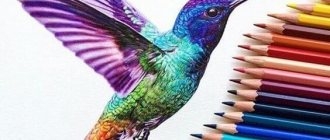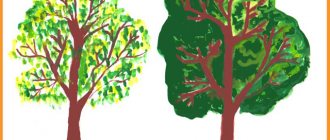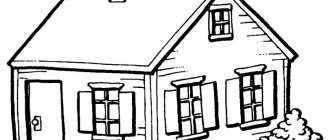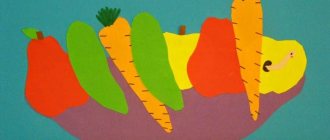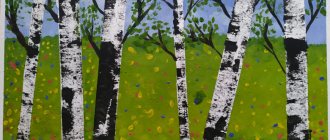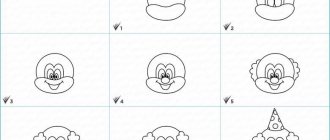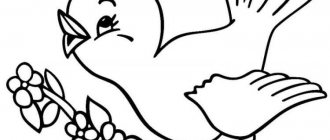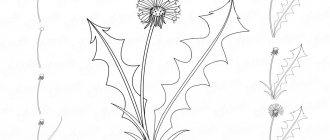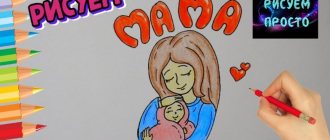Representatives of the bird world are found in nature in an amazing variety, they symbolize the sky, freedom, life and abundance. Sketches of birds often appear in children's albums.
Drawing birds is not only exciting, but also educational, because children get acquainted with forest, domestic and exotic species.
Parents should tell their child about their value to the natural environment, their anatomical structure and differences, sometimes even watching the winged singers from the window and feeding them in the winter.
How to draw a bird
The process of drawing birds will be greatly simplified if you follow the recommendations and practice regularly, improving your hand. Master classes will be useful for children of all ages, helping them cope with the difficult task of mastering artistic skills.
Owl
Let's try to recreate this expressive image step by step:
- Work begins with two circles with cross-shaped lines at the smaller top figure.
- We outline them with smooth lines, continuing the back part, ending with the tail.
- We finish drawing the legs with three toes.
- We depict round eyes with eyebrows and characteristic ears.
- Below we place a beak that looks like a hook.
Now we need to display the plumage, which lies in rows on the wing, tail, and the fluff on the chest, conveyed by shading. The pencil drawing of the bird is ready.
Penguin
Not a flying, but a floating specimen, recognizable from cartoons and movies, also belongs to the family of birds; its appearance is not difficult to reproduce in profile. You will need to outline a vertical egg ending in a small head with a beak. Draw a short tail and legs.
The most important thing is to correctly paint the picture with paints or felt-tip pens - the head area, the back with wings-flippers are black, and the abdomen is white.
Chick
The proposed version of the image of a chick is simple. We draw an arc from bottom to top, ending with an arrow-nose. We draw the eyeball with the pupil side by side. From the arrow we continue the bow to the starting point, ending it with a tail. We draw on the arched wing and thin legs.
Parrot
Many people keep these bright individuals at home; let’s draw a striking bird step by step:
- We sketch out a diagram of 2 ovals, on the left we draw a back line that turns into a falling tail.
- We use a semi-rounded ruler to mark the bottom of the wing.
- Draw the beak-hook, eyes-circles and paws.
We proceed to contrasting coloring, conveying the feeling of feathers. We use red, blue, yellow. Using a black tone we highlight the base of the beak and the edges of the feathers.
If you want to capture a parrot in flight, use a pair of arched rulers to show outstretched wings with an arched lower edge; its face will be half turned towards us, complemented by a beady eye and a hump nose.
Woodpecker
The cautious and beautiful little bird, by knocking on a tree trunk, not only gets food for itself, but also lets other “relatives” know about the boundaries of its territory, attracting females in the spring. Procedure:
- We draw an oval head and a body with extending wings.
- We draw the line of the beak, legs and move on to the hanging tail.
- We detail the wing by tracing the contours and highlighting the feather strokes.
- We remove unnecessary lines and refine the eye.
Decoration will add realism - a red head, a white chest. We emphasize the beak and other body fragments with black coloring.
Stork
This handsome guy has long legs, an ovoid body and a small head with an elongated yellow nose. Having completed the sketch, we clarify the details. Using a series of rulers we draw out the raised wings.
The ankle-shaped, yellowish limbs have a thickening in the middle. The aerial inhabitant has a snow-white color with a gray-blue tint at the tips of the plumage. Using strokes we emphasize the fluff in the chest area.
If you take on a heron, then give its neck a greater bend, and draw a crest on the back of its head, let it keep its balance on one limb, tucking the other, as it is more accustomed to do when hunting for river life.
Bullfinch
Let's depict a small bird with a colorful appearance that does not fly away to hot countries for the winter:
- Draw an oval body and a circle head.
- From them we draw a line that turns into a wing.
- We fix the neck and tail segment.
- The paws will tenaciously hold on to the branch.
We paint the figure - a bright red breast, a white spot under the eye, reminiscent of a bead with a dot, highlighted darkened plumage.
flying seagull
At first, the task seems difficult, however, even a child can do it:
- A round head and an elongated body with a lower convexity are outlined.
- The near wing has a more elongated format compared to the far element.
- The continuation of the figure will be the tail.
- The bird's legs are folded and pressed.
- We display zigzag feathers more accurately.
Hatching shows the fall of the shadow. It is worth noting that the dimensions of the wings of flyers increase in direct proportion to the size of the body.
Specifics of drawing birds in the senior group of preschool educational institutions
Children 5–6 years old are able to create beautiful, expressive drawings and convey the shape of objects and their components well. Children's horizons broaden significantly: new knowledge is acquired in the process of observing the world around them and reading fiction. The guys can already depict objects that they have never seen (as for birds, this is, for example, a penguin).
The color spectrum with which children work is expanding. The drawing is based on beautiful color combinations.
If in elementary and middle preschool age children depicted birds in the form of checkmarks, then in the older group the teacher’s task is to teach them to draw them correctly. The teacher must form in children an idea of the external appearance of birds, an understanding that they all have a similar structure, although they differ in color, size and shape of body parts. The children learn that all birds have an elongated body and the same head position. When moving, the position of the head and tail changes, and the wings open.
Drawing birds should ideally be preceded by modeling on a similar topic.
In order for preschoolers to realistically depict birds, preliminary work must be carried out before such classes: observing birds on walks, looking at numerous illustrations.
There are some difficulties in drawing birds. Children must learn the basics of depicting them. The drawing begins with an outline - an elongated body in the shape of a large drop (pointed towards the end) and an oval head. After this, wings, a tail, paws and an eye near the beak are added. The accuracy and quality of the entire drawing depends on the correct contour.
The teacher explains to preschoolers how the bird's body parts are located during flight and when moving on the ground (the tail is straightened or folded). In addition, you can draw birds pecking at food or sitting on a tree branch.
Of course, it is better to start depicting birds in the older group with those individuals that children can observe in everyday life: this is a sparrow, titmouse, bullfinch, pigeon, etc. We must teach the children to notice the difference between birds themselves, compare them, highlight key features, then drawing will be easier. For example, an owl is round and fat. The stork is thin-legged with a long graceful beak. The swan has a long neck, is very beautiful, with large, sweeping wings. The penguin seems to be dressed in a tailcoat, clumsy, with short wings, and has a funny crest on its head. The rooster has a powerful chest, strong legs, a beard, a beautiful comb, and most importantly, a multi-colored tail. The bullfinch is distinguished by its red breast.
When preschoolers learn to draw realistic images well, the teacher can invite them to depict a bird in a fairy tale interpretation - “Firebird”, “Bird of Happiness”, “Magic Bird”. Note that this topic is creative, and the teacher offers children several diverse samples for familiarization. In addition, children choose their own colors.
Materials used and base
Birds in the older group are depicted on a sheet of paper of the usual size. When painting with gouache or watercolors, the base is tinted in advance by the teacher. If children have to draw birds soaring in the sky, then it should be a blue background.
For collective work, the teacher offers the children a sheet of whatman paper, where, depending on the nature of the composition, they first draw a tree with many branches, a large feeder, or a village poultry yard.
Preschoolers of this age draw birds with both paints and colored pencils. It is better to paint white birds, for example, a swan, a stork or a goose, with gouache so that they are more visible against a colored background. The same applies to black and white - penguin and swallow. A titmouse, a bullfinch, an owl, a chicken, a sparrow, and a dove can be drawn with colored pencils or even wax crayons. In some cases, felt-tip pens are also suitable, for example, when depicting a bright cockerel.
Drawing with felt-tip pens
To preliminary draw the outline, use a simple pencil.
Techniques and techniques that should be used when drawing in the senior group
When drawing in the older group, the teacher should practice with the children the techniques of correctly painting a silhouette with a brush. Small parts of the body - beak, eyes, paws, tail - are carefully painted on with the tip of the brush. In this case, the instrument should be held in your hand almost vertically. The larger oblong body of the bird and its wings are painted over with all the pile, while the brush is tilted towards the paper. When the paint dries, you can additionally use the tip of the brush to indicate the direction of the feathers - the image will become more realistic.
Hatching with a pencil should be done in one direction, in addition, there should be no white spots inside the outline.
Depending on the size of the part to be painted, preschoolers should adjust the range of their hand movements.
Additional types of visual activities used, the relevance of an individual approach
The image will become more original, and the productive activity itself will be more exciting for children, if you diversify the composition with applicative or plasticine elements. For example, a bird can peck at a worm or caterpillar molded from plasticine (in the form of a flagellum or sequentially stuck balls). Small black eyes of birds can be sculpted from plasticine. If a bird soars in the sky, you can depict the sun using plasticineography. A bullfinch can sit on a rowan branch with sculpted red berries.
Applique details will be especially appropriate when drawing fairy-tale birds. This can be colored foil, shiny sequins or candy wrappers. You can decorate an elegant cockerel in a similar way.
Small breeds
Sparrows are the most common family; their oval body is equipped with a round head and a triangle-beak. Draw the wing, eye and thin legs. An interesting titmouse with a round yellow belly.
The smallest bird is the hummingbird, which is distinguished by its long nose, thickened at the base, with which it drinks nectar from flower buds; it has also earned fame for its ability to fly backwards. The picture will turn out believable if you carefully work out the feathers of the birds.
Crow
Flocks of crows have chosen places close to humans; these birds are smart and intelligent. We offer a way to draw this bird easily and simply:
- On one diagonal we draw contour sketches of the head and torso, thickened towards the bottom and a triangular tail.
- We connect these parts with a stroke, completing the beak and two paws with claws.
- We detail the wing and give the tail a flat appearance.
- Having removed the basting, we move on to the plumage.
- Inside the eye we designate a highlight; an additional curve goes from it to the beak.
You can start shading with a black pencil, emphasizing the feather coating with contrast. If you choose the image of a magpie, then remember its peculiar black and white coloring and long tail.
Drawing domestic and migratory birds: lesson notes
| Author's full name | Title of the abstract |
| Volokhova O. | "Brave Cockerel" Educational objectives: learn to draw a cockerel with watercolors, conveying its characteristic features and creating an expressive image. Developmental tasks: develop color perception, sense of proportions, improve brush painting technique. Educational tasks: cultivate love and caring attitude towards poultry. Integration of educational areas: “Artistic creativity”, “Cognition”, “Communication”, “Socialization”, “Health”. Demo material: a picture of a rooster, an audio recording of a rooster crowing. Handout: sheets of white paper according to the number of children, watercolors, sippy cups, brushes, coasters, napkins. Progress of the lesson: Teacher's story about a rooster. It turns out that this bird was not always domestic. The ancestors of the rooster from India and China lived in the forest in trees and built nests on the ground. Loud singing was their protection from other birds. Domestic roosters have not lost this habit either. Villagers tell the time by the crow of a rooster. “The first roosters” sound at one o’clock in the morning, an hour later the second roosters sound, and at four o’clock the rooster’s voice is heard throughout the village, announcing that dawn will soon come. The guys look at the image of a rooster and a hen with a chicken, find out how they differ. The rooster is larger, it has a crest on its head, “spurs” on its legs (sharp claws for protection), and bright plumage, especially the tail. The teacher reads a poem about a cockerel.
A conversation about the character of the rooster in this work (brave, courageous, courageous, capable of protecting hens and chicks). He is like this in almost all fairy tales. The teacher asks the children in which fairy tales the cockerel appears. The teacher reports that since ancient times, people believed that the crow of a cock protects the house and embroidered the image of a rooster on towels, tablecloths, and painted it on dishes and furniture. Preschoolers are also asked to pretend to be a rooster. The game “Fighting Roosters” is played: two participants hide their hands behind their backs and, standing on one leg, try to push the opponent out of the circle (with their shoulder or torso). Independent work - drawing a cockerel. Exhibition of children's works. The teacher sums up the lesson and says that the cockerels will protect the children from adversity. |
| Geleverina Yu. | "Wintering Birds" The lesson begins with a game with a ball: children, standing in a circle, take turns naming the bird. Conversation about birds: · Where we meet them (in the city, in the forest, on reservoirs). · how they differ from each other (size, color, singing, habitat) · Where they find food in winter (in feeders, berries on trees). · What can be put in the feeder (bread, grains, seeds, lard). · How birds keep themselves warm in winter (they tuck their legs under them and hide them in the fluff). The didactic game “Cut Pictures” is played: children in pairs pick out images of birds. Physical school is carried out:
Didactic game “Finish the sentence (for example, a magpie is a wild bird, and a chicken...). The teacher reads the poem “Feeder”
Children are invited to draw a wintering bird of their choice. |
| Borodacheva O.V. | "Owl" The lesson begins with a riddle about an owl:
The teacher recalls with the children the fairy tale “The Owl” by V. Bianchi, and knowledge about the significance of this bird in nature is consolidated. Looking at pictures of an owl. Highlighting its distinctive features: large head and eyes, almost no neck, thick plumage. Rounded wings and a short tail help this bird fly silently. The owl's eyes, although large, see practically nothing. Since this bird is a predator, it has a powerful curved beak and sharp claws. The didactic game “Who Says What” is played (children reproduce the voices of various birds). Physical exercise "Owl"
The teacher explains the principle of drawing an owl, and then the children begin the practical part of the lesson (the owl is drawn sitting on a tree branch). Analysis of children's drawings: the teacher asks to highlight the largest owl, the smallest, as well as the sad and cheerful one. The outdoor game “Day and Night” is played. |
| Fomina I.A. | "Swan" At the beginning of the lesson, the teacher tells the children that an artist she knows gave her black and white pictures. We need to figure out together what is depicted on them - the children are shown slides depicting silhouettes of different birds. Preschoolers name them, highlighting characteristic features for each (for example, a swallow has a forked tail, a stork has a long neck, legs and beak). The conclusion is that all these birds are migratory. The didactic game “Finish the sentences” is played (all phrases are related to the swan). Demonstration of a sample image of a swan (swimming in the lake). Discussion on how to complete the drawing. Before working independently, children warm up their fingers by rolling a pencil between them. Independent activity of children. Exhibition of works. The teacher appoints one of the children as a tour guide, and he talks about the children’s works. |
Unusual specimens
There are varieties that cannot be confused with anyone else. For example, this is an overweight pelican, with a beak-bag where it stores fish, or a toucan with a special structure of a voluminous nose-beak.
Pink flamingos on elongated legs are graceful and spectacular, and the nimble swallow is distinguished by its forked tail and erected hut nests.
The highlight of the peacock is a chic blossoming fan-tail with diamond-shaped colored patterns, and its head is crowned with a “crown” of corollas with circles.
Let's depict a formidable eagle:
- We make a general sketch of the body with all its fragments.
- We start detailing from the head with a slightly open beak-hook and an eye with a pupil under the eyebrow.
- We approach the back, lowering ourselves onto the tail section.
- The sitter has sharp claws on his large paws, and specific “pants” on his shins.
- We convey the plumage on the powerful wings by shading.
We draw the stump on which the predator is sitting.
Graceful swans are impressive, associated with fidelity and love. The simplest version begins by drawing the number two flowing into the body rocking on the waves. These birds have a characteristic marking on their wide beak and webbed feet.
Fairytale variations
The firebird from the fairy tale has sweeping fan-like wings and a flowing plume-tail, a non-trivial fiery coloring, performed at its own discretion.
It is filled with figural patterns of different colors, from which streaks radiate, comparable to hair. Next, you need to blacken the edges of the plumage and fix the head crest.
Also interesting is a character who has an unusual, bright appearance. This is a circle with a polygonal beak, on the sides of which there are huge eyes with the obligatory “bags” under them. There is a crest on the head and a miniature tail on the left. You can start coloring.
Dove of peace
When thinking about how to draw a bird for children, remember the dove - a fluttering creature with a flowering twig in its beak, which is a symbol of peaceful life.
Having outlined the oval body and the circle head, they are combined by adding a carved tail. The wings, open to the sides, can be compared in shape to an inverted trapezoid. The final stroke is to give the edges of the feathers fragmentation with zigzags.
Of course, it is impossible to cover all the inhabitants of heaven. Starting with one image and strengthening your skills, move on to the next example. Children will certainly enjoy this exciting pastime, which not only develops fine motor skills, but also expands their horizons and knowledge about the earth's fauna.
Summary of a drawing lesson in the senior group “Birds of Migratory”
Summary of a drawing lesson in the senior group “Birds of Migratory”
Kind of activity:
direct educational
Age group:
senior group
Subject:
"Migratory birds"
Target
: consolidate methods for conveying bird proportions; develop creative imagination; cultivate a caring attitude towards the environment; consolidate and expand knowledge about wintering and migratory birds. We continue to develop fine motor skills; observe the sequential execution of the drawing; cultivate a love for birds.
Software tasks:
Educational:
- practice drawing birds;
- consolidate the methods of making a sketch with a simple pencil and then painting over it with watercolors;
Educational:
- develop the ability to analyze drawings;
-develop memory, thinking, fine motor skills of the hands, and the ability to enjoy the results of one’s work.
Educational:
— caring attitude towards birds and nature;
- to form in children the desire to complete the work they start.
Methods and techniques:
-Visual: looking at illustrations (paying attention to the characteristics of birds - size, color, leg length, beak shape).
-Verbal: conversation, explanation;
Preliminary work:
looking at illustrations of birds, viewing slides “Migratory Birds”.
Material and equipment:
pictures of birds; drawing paper, pencil, eraser, watercolor, brushes, water jar, palette.
Progress of educational activities:
Educator:
- Let's see what birds are sitting on our tree? Name them. (crow, magpie, woodpecker, tit, black grouse)
- Oh, guys, I can’t understand something, are all the birds gathered on the tree? Help me to understand. (Children find out that all birds winter and there are no migratory ones.)
- What happened? Where have the migratory birds gone? (children's answer)
- Guys, let's think, why are birds called migratory? That's right, migratory birds are birds that come to us in the spring, and in the fall they fly to warmer climes. Why do these birds fly away from us in the fall?
-All these birds eat insects. And in the fall the insects disappear. Birds are deprived of their main food and are forced to fly to warmer climes. There are many insects there all year round. Let's list the migratory birds (swallow, crane, stork, cuckoo, swan, starling, wagtail, duck, lark, heron)
- Please look at all of these and name their similarities and differences. (similarities are the body, head, tail, etc.; differences are the color of the plumage). You and I have already drawn a bird with a pencil. Today we will also draw with paints.
Physical exercise “A flock of birds is flying south”
A flock of birds flies south, the sky is blue all around. (Children wave their arms like wings) In order to fly faster, you need to flap your wings. (Children wave their hands more intensely) The sun is shining in a clear sky, An astronaut is flying in a rocket. (Stretching - arms up) And below the forest, fields - The earth is spread out. (Low bend forward, arms spread to the side)
The birds began to descend
Everyone sits down in the clearing.
They have a long way to go, the birds need to rest. (Children sit in a deep squat and sit for a few seconds) And again it’s time to hit the road. We have a lot of flying to do. (Children stand up and flap their “wings”)
Here comes the south. Hooray! Hooray! It's time for us to land. (Children sit at tables)
- Now look at these pictures. Let's name what parts a bird consists of? (head, body, tail, wings) What shape is the head? (round) What shape is the body? (oval) What shape is the tail? (can have a triangular shape, or can be forked, like a swallow) The wings have a curved shape if the bird is flying, and oval when folded. The beak is triangular.
— You know how to draw geometric shapes. Therefore, you can easily depict the components of birds. You just need to connect them correctly.
Practical part:
-First, let's draw an oval body. Then we will draw the head. Oval wings, slightly pointed at the ends - these are the longest feathers. Rectangular tail, triangular beak, round eyes. And then, let's draw the paws, draw the feathers.
— We take simple pencils and make sketches. (children draw). Then we will paint our bird with paints and create a background.
Result:
- Well done boys. You all did your best and we got wonderful birds.
— What migratory birds do we know?
-Well done guys, you did a very good job today. With each lesson your work gets better and better! Well done!
After class, the work is displayed in a corner along with the original pictures, so that other children can look and compare.
